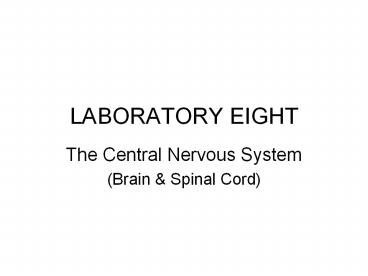LABORATORY EIGHT - PowerPoint PPT Presentation
1 / 12
Title:
LABORATORY EIGHT
Description:
LABORATORY EIGHT The Central Nervous System (Brain & Spinal Cord) Nervous Tissue Neurons: functional cells that transport electrical impulses Neuroglia: non ... – PowerPoint PPT presentation
Number of Views:69
Avg rating:3.0/5.0
Title: LABORATORY EIGHT
1
LABORATORY EIGHT
- The Central Nervous System
- (Brain Spinal Cord)
2
Nervous Tissue
- Neurons functional cells that transport
electrical impulses - Neuroglia non-conductive cells
- Schwann cells
3
Human Brain
Transverse fissure
4
Human Brain Right Half
Septum pellucidum
Fornix
Choroid Plexus
Optic Chiasma
Corpora quadrigemina
Mammilary body
Cerebral aqueduct
Fourth ventricle
5
Human Brain Ventricles
Site of massa intermedia
6
Cerebral Meninges(Three layers of protective
connective Tissue in CNS)
7
Dura Mater in Cerebral Meninges(Fig 8.15, p140)
- Modified in two areas
- Falx cerebri penetrates longitudinal
fissurebetween brain hemispheres - Tentorium cerebelli penetrates transverse
fissure that separates the cerebrum from the
cerebellum
8
Spinal Cord Meninges
9
Cross-Section of Spinal Cord(Also study fig
8.12, p138)
Dorsal gray horn
White matter
Ventral gray horn
Central Canal
10
Electroencephalogram
- EEG is a record of the electrical activity that
takes place in the brain - Brain waves are characterized by their frequency
(cycle per second) - Fig 8.16, p140 - Alpha (8-13 cps) relaxed with eyes closed
- Beta (14-25 cps) alert, performing a task
- Theta (4-7 cps) normal in children, but abnormal
in adult - indicates emotional/mental imbalances - Delta (lt4 cps) deep sleep
- Report 8C, p149
11
Laboratory Report
- P145, Q1 P146, Q2 - bottom of the page
- On Fig 8.3 and Fig 8.5, draw a thick black line
that crosses thalamus - Table 8.1
- Compare the size of characteristics in question
to the rest of the brain of the same species
e.g., the size of the cerebellum of human compare
to the rest of the human brain
12
Sheep Brain DissectionGoogle search under
image for Sheep brain dissection
- Each lab pair should obtain a sheep brain,
dissection tools, and a tray - Choose a sheep brain with intact pituitary gland
- Note the 1800 relationship between the cerebrum,
cerebellum, and spinal cord - Identify the superficial structures listed under
8B Procedure, step 1 (p134) and step 3 (p136) - Identify the longitudinal fissure and transverse
fissure, but the central and lateral fissures can
not be identified on the sheep brain - Grasp the sheep brain gently by the cerebral
hemispheres and the cerebellum, and separate them
at the transverse fissure to see the corpora
quadrigemina (superior inferior colliculi)
pineal body (step 5, p137) - To prepare for pituitary gland removal, carefully
cut Trigeminal V cranial nerve, 1cm above its
attachment site to the brain - When removing the pituitary gland, look
underneath it to make sure no cranial nerve is
attached - If you see a string structure attached to the
pituitary gland from one side and to the floor of
the brain from another side, clip it with a pair
of scissors closer to the pituitary gland - Identify cranial nerves I, II, III, IV, V, VI and
XI - Section the sheep brain by placing it ventral
side up. - Make a long, smooth, midsagittal cut. Be sure to
completely divide the brain in half - Identify the structures listed under step 2, p135
- Observe the prepared coronal section of the sheep
brain and identify the assigned structure on step
7, p137 - Take half of the dissected brain home, and return
them to the lab when done.





![[PDF] Formulary for Laboratory Animals Ipad PowerPoint PPT Presentation](https://s3.amazonaws.com/images.powershow.com/10080757.th0.jpg?_=20240718025)







![[PDF] Immunology & Serology in Laboratory Medicine 7th Edition Free PowerPoint PPT Presentation](https://s3.amazonaws.com/images.powershow.com/10076362.th0.jpg?_=20240711081)

















